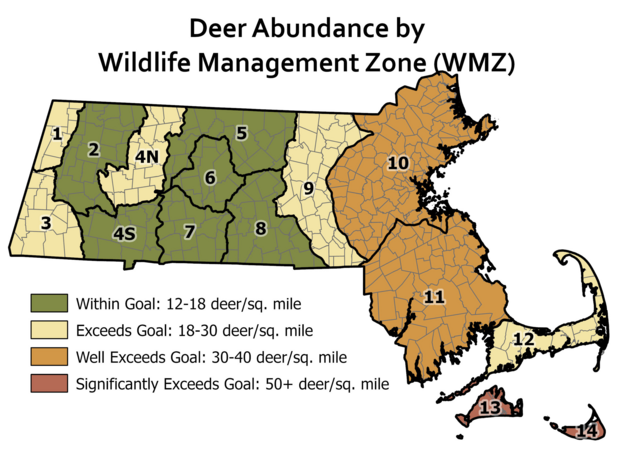Overview
White-tailed deer are an important part of the ecosystem and a valuable natural resource. Deer densities vary widely in different parts of the Commonwealth. In most of central and western Massachusetts, densities are about 12–18 deer per square mile, which is within the statewide goal. In areas of eastern Massachusetts, densities can reach over 30–50 deer per square mile. Martha’s Vineyard and Nantucket densities are over 55 and 85 deer per square mile respectively. Deer densities are even higher in areas where hunting access is restricted. MassWildlife estimates deer populations across the 15 Wildlife Management Zones by annually evaluating hunter harvest data and biological data collected at checkstations. To better understand local deer densities and impacts to habitat, MassWildlife biologists also perform vegetation surveys and pellet counts. Additionally, hunters in Massachusetts provide valuable information by reporting deer sightings in a voluntary online survey each year.
Historically in Massachusetts, deer populations were controlled by three main predators: mountain lions, wolves, and humans. Now that mountain lions and wolves are absent in the Commonwealth, deer populations are able to grow in numbers in areas without regulated hunting, despite vehicle collisions and predation by black bears, bobcats, and coyotes.
When deer numbers exceed human tolerance, they are often viewed as pests and can cause public safety issues and property damage. Additionally, when deer numbers exceed what the habitat can support, forest health can be severely degraded and negatively impact other animals and plants.
Regulated hunting
MassWildlife uses regulated hunting during three distinct seasons (archery, shotgun, and primitive firearms) to manage deer numbers across the state. The Fisheries and Wildlife Board oversees any changes to hunting seasons, bag limits, and antlerless deer permit numbers, which are set annually to achieve desired deer densities across 15 Wildlife Management Zones. MassWildlife's deer management strategy seeks to keep deer numbers in balance with social tolerance and below the level where major habitat impacts are observed. Hunters provide a unique service in helping to achieve this goal.
In areas of Massachusetts where there is adequate hunting access, deer numbers appear to be balanced with the habitat and within MassWildlife's management goals. In areas where effective hunting methods are restricted by town by-laws prohibiting the discharge of firearms and in areas where hunting access is severely limited through discharge setbacks, land closures, or town by-laws requiring written permission, not enough deer are removed from the population to stabilize or reduce deer numbers. This is occurring in much of eastern Massachusetts, but also any place in the state where large areas of land are closed to hunting or restrictions to hunting are prohibitive. Towns and landowners must work proactively to increase hunting access to address deer issues sooner than later, as deer numbers will continue to rise and make reduction efforts even more difficult in the future.
MassWildlife staff are available to assist with questions from the public and town managers regarding the complexities of deer management and effective strategies to reduce deer numbers. It is important that landowners and hunters cooperate to safely and effectively manage the Commonwealth's deer resource within desired population density goals. If managed correctly, we can all enjoy the benefits of a healthy statewide deer population.
